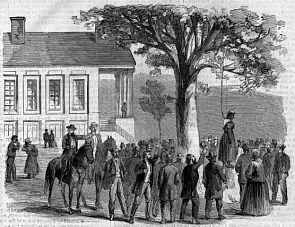
| The Journal for MultiMediaHistory Volume 1 Number 1 ~ Fall 1998 |
HarpWeek: The Civil War Era, (1857-1865) Norfolk, Virginia: HarpWeek, 1997. 12 CD-ROMs. PC, Windows 95 and Windows NT. [Detailed technical information is available at the HarpWeek Web site: http://www.harpweek.com]
 |
The product is very
expensive ($16,900) and does have some technical limitations. The program only runs on Microsoft Windows 95, Windows NT 3.5,
or later operating systems. It can be mounted on a Local Area Network (LAN)
for one simultaneous user or mounted on a stand-alone. If mounted in a
stand-alone configuration, the PC must have abundant memory on the hard
drive for the search engine software. The preferred CD-ROM installation
is using a jukebox or fully dedicated towers which can store and quickly
access the twelve disks (more if later installments are purchased). An
external CD-ROM drive and disk-caddy swapping will not work effectively
as the program was not designed to be run that way.
 |
Carolina, courthouse. Harper's Weekly, September 30, 1865. |
When the user does find relevant articles, the images can be viewed in three formats: postage stamp, light box (which shows more than one postage stamp image at once), and full page. The postage stamp images are too small to be read which may limit their usefulness, except perhaps in the cases of the larger illustrations. The full page images are quite spectacular. Images can be printed or saved to floppy diskettes in a JPEG format.
The drawbacks of HarpWeek
may make some prospective buyers think twice before making such a substantial
investment in the software as well as the requisite hardware. For those
who do purchase the CD-ROMs or subscribe to a Web-version, the rewards will be considerable. The comprehensive index
makes the old Harper�s Weekly much more accessible and brings new
usefulness to this important chronicle of a troubled time in American history.
Joel D. Kitchens,
Texas A&M University
CD-ROM Review of HarpWeek
Copyright © 1998 by the Journal for MultiMedia History
![]()
![]() Comments
to: [email protected]
Comments
to: [email protected]
Contents:
JMMH, Volume 1 Number 1 ~ Fall 1998